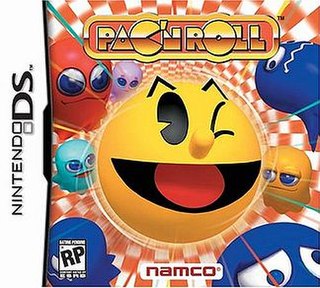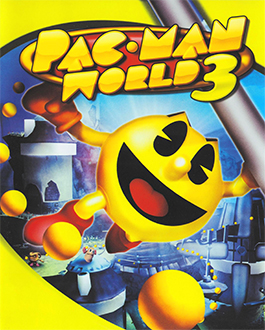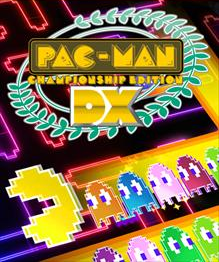
Pac-Man, originally called Puck Man in Japan, is a 1980 maze action video game developed and released by Namco for arcades. In North America, the game was released by Midway Manufacturing as part of its licensing agreement with Namco America. The player controls Pac-Man, who must eat all the dots inside an enclosed maze while avoiding four colored ghosts. Eating large flashing dots called "Power Pellets" causes the ghosts to temporarily turn blue, allowing Pac-Man to eat them for bonus points.

Sonic Adventure 2 is a 2001 platform game developed by Sonic Team USA and published by Sega for the Dreamcast. It features two good-vs.-evil stories: Sonic the Hedgehog, Miles "Tails" Prower, and Knuckles the Echidna attempt to save the world, while Shadow the Hedgehog, Doctor Eggman and Rouge the Bat attempt to conquer it. The stories are divided into three gameplay styles: fast-paced platforming for Sonic and Shadow, multidirectional shooting for Tails and Eggman, and action-adventure exploration for Knuckles and Rouge.

James Bond 007: Nightfire is a 2002 first-person shooter video game published by Electronic Arts for the GameCube, PlayStation 2, Xbox and Microsoft Windows, with additional versions released for the Game Boy Advance in 2003, and the Mac OS X in 2004. The computer versions feature modifications to the storyline, different missions and the removal of driving sections used in home console versions.

Pac-Man Vs. is a 2003 maze video game developed by Nintendo and published by Namco for the GameCube. In the game, one player takes control of Pac-Man, who must eat all of the pellets in the maze, while the others control the ghosts to try to catch them. The objective is to be the first to reach a set number of points, selected before the game begins. The player controlling Pac-Man uses the Game Boy Advance to play, while the others use the television to control the ghosts. The game requires the GameCube - Game Boy Advance link cable in order to play.

Ty the Tasmanian Tiger is a 2002 platform video game developed by Krome Studios and published by Electronic Arts for the GameCube, PlayStation 2 and Xbox systems. The game was remastered in HD for Microsoft Windows and was made available through Steam in 2016. A remastered version published by Krome Studios was also developed for the Nintendo Switch, PlayStation 4, Xbox One, and Xbox Series X/S. The Nintendo Switch version released in North America in March 2020, and in Europe, Australia, and New Zealand the following month. The PlayStation 4 version was released on 25 July 2020. The Xbox One and Xbox Series X/S version was released on 14 October 2020.

Pac 'n Roll is a 2005 platform video game developed and published by Namco for the Nintendo DS. It stars a 3D Pac-Man as the user rolls him through the playing field using the touchscreen. The game sees Pac-Man; who has been turned into a ball, go on a journey with his new fairy companion Krystal, to save his friends from Golvis and the ghosts.

Pac-Man Fever is a party game developed by Mass Media and published by Namco, released for GameCube and PlayStation 2 on September 3, 2002, exclusively released in North America. Players move about on a virtual game board, with the object of the game being to reach the end first. It allows for up to four players, featuring six characters from other Namco games to choose from: Pac-Man (Pac-Man), Astaroth (Soulcalibur), Heihachi Mishima (Tekken), Ms. Pac-Man (Pac-Man), Tiger Jackson (Tekken), and Reiko Nagase.

Pac-Attack, also known as Pac-Panic, is a 1993 falling-tile puzzle video game developed and published by Namco for the Super Nintendo Entertainment System and Sega Genesis. Versions for the Game Boy, Game Gear and Philips CD-i were also released. The player is tasked with clearing out blocks and ghosts without them stacking to the top of the playfield — blocks can be cleared by matching them in horizontal rows, while ghosts can be cleared by placing down a Pac-Man piece that can eat them. It is the first game in the Pac-Man series to be released exclusively for home platforms.

Crash Bandicoot: The Wrath of Cortex is a 2001 platform game developed by Traveller's Tales and published by Universal Interactive. It was first released for the PlayStation 2 and later ported to the Xbox, and GameCube, with Eurocom developing the GameCube version. It is the fourth main installment and the sixth overall in the Crash Bandicoot video game series, being the first of the series to not be released solely for a PlayStation console.

Pac-Man World is a platform video game developed and published by Namco for the PlayStation. Controlling Pac-Man, the player must complete each of the game's six worlds by collecting a certain amount of pellets to open up an exit door. The plot follows Pac-Man's enemies, the ghosts, crashing his 20th birthday and kidnapping his friends and family to bring them to their homeland of Ghost Island — with his birthday in ruins and his family in trouble, Pac-Man sets out to rescue them and defeat the ghosts.

Gauntlet Dark Legacy is an arcade video game released in 1999. It is the seventh title in the Gauntlet series, and is an expansion of the previous title in the series, Gauntlet Legends. The expansion adds five new levels, and four new character classes: Dwarf, Knight, Jester, and Sorceress. It also adds a large number of secret characters, some of which can be unlocked in the game, while others are only accessible by entering specific cheat codes.

Pac-Man World 3 is a platform video game developed by Blitz Games and published by Namco for the PlayStation 2, GameCube, Xbox, PlayStation Portable, Nintendo DS, and Microsoft Windows. The Nintendo DS version was ported by Human Soft. Released in 2005, it is the third and final installment in the Pac-Man World trilogy and the only one to not be released in Japan. It also features a speaking Pac-Man for the first time ever outside of the cartoon series.

Spider-Man is a 2002 action-adventure game based on the 2002 film of the same name. It was released for the PlayStation 2, Xbox, GameCube, Microsoft Windows, and Game Boy Advance on April 16, 2002, in North America, and June 7 in Europe. The Game Boy Advance version was later re-released and bundled on Twin Pack cartridge with Spider-Man 2 in 2005. Published by Activision, the console versions were developed by the company's then-recently acquired subsidiary Treyarch, who had previously ported Neversoft's 2000's Spider-Man to Microsoft Windows and Dreamcast. LTI Gray Matter developed the Microsoft Windows version and Digital Eclipse developed the Game Boy Advance version.

Pac-Man World Rally, known in Europe as Pac-Man Rally, is a kart racing game in the Pac-Man series. It was published by Bandai Namco Games, and released on August 22, 2006, for the PlayStation 2, GameCube, PlayStation Portable, and Microsoft Windows. An Xbox version of the game was cancelled, though a preview of the game can be found in the Xbox release of Pac-Man World 3.

Bionicle is a 2003 platform video game developed by Argonaut Games and published by Electronic Arts and Lego Interactive for GameCube, PlayStation 2, Xbox, and Microsoft Windows. A port was released for Mac OS X, and a version was also developed for the Game Boy Advance. In the home console version, the player controls the Toa, elementally-powered warriors, as they traverse through levels; some levels are 3D platformers, while others utilize mechanics like snowboarding or lava surfing. The game's story, which takes creative liberties with the official Bionicle story, follows the Toa as they defend the island of Mata Nui from the return of the evil Makuta and his minions.

Cars is a 2006 adventure racing game published by THQ. The game is based on the 2006 film of the same name. It was released for the PlayStation 2, GameCube, Xbox, Microsoft Windows, Game Boy Advance, Nintendo DS, and PlayStation Portable in June 2006, with versions for the Xbox 360 and Wii released later that year. The Wii version includes functionality geared towards its Wii Remote controller and was a launch game for the system. Taking place after the events of the film, the game follows Lightning McQueen as he participates in the new racing season with his goal set on finally winning the Piston Cup. While doing so, he races and trains with the local community of Radiator Springs.

The SpongeBob SquarePants Movie is a 2004 platform game based on the film of the same name and published by THQ for the PlayStation 2, Xbox, GameCube, Microsoft Windows, and Game Boy Advance. The PlayStation 2, Xbox, and GameCube versions were developed by Heavy Iron Studios. The Game Boy Advance version was developed by WayForward Technologies. The Microsoft Windows version was developed by AWE Games. The Mac version was developed by Aspyr. Most of the film's cast reprise their roles.

Baldur's Gate: Dark Alliance is a 2001 action role-playing video game developed by Snowblind Studios and published by Interplay Entertainment subsidiary Black Isle Studios for the PlayStation 2 and the Xbox consoles, with High Voltage Software handling the GameCube port, and Magic Pockets developing the Game Boy Advance version. CD Projekt was developing a version for Microsoft Windows, but was ultimately cancelled. In 2021, a 4K port of the game was released for the Xbox One, PlayStation 4, PlayStation 5, Xbox Series X/S, Nintendo Switch and PC.

Pac-Man Championship Edition DX is a 2010 maze video game published by Namco Bandai Games for the Xbox 360 and PlayStation 3, later ported to Steam and iOS. It is the sequel to the 2007 game Pac-Man Championship Edition, which was the last game developed by series creator Toru Iwatani. The player controls Pac-Man as he must eat all of the dots in the maze while avoiding colored ghosts that pursue him. A bonus item will appear once the player has eaten all dots on one side of the maze, causing the layout to change. Several additions were made over the original, such as bombs that send all ghosts to the regeneration box and sleeping ghosts that will give chase when Pac-Man moves past them.

The Cat in the Hat is a 2003 2.5D platform game for PlayStation 2, Xbox, Microsoft Windows and Game Boy Advance. The PlayStation 2 and Xbox versions were developed by Magenta Software. The Windows and Game Boy Advance versions were developed by Digital Eclipse. All versions of the game were published by Vivendi Universal Games. It is based on the 2003 film of the same name, which was released shortly after the game. A version for the GameCube was planned, but was never released. The Windows version is compatible with Windows 98, Windows ME, Windows 2000, Windows XP, Windows Vista, and Windows 7. It is not compatible with Windows 95 or earlier versions of Windows or Windows 8 and later versions of Windows.





















